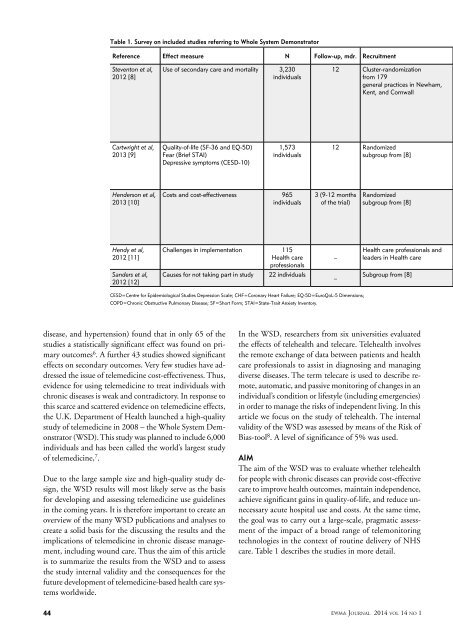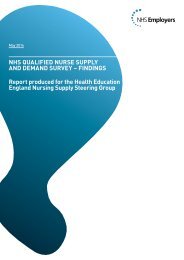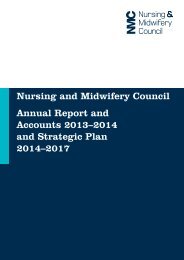Journal_1_2014_final_WEB
Journal_1_2014_final_WEB
Journal_1_2014_final_WEB
You also want an ePaper? Increase the reach of your titles
YUMPU automatically turns print PDFs into web optimized ePapers that Google loves.
Table 1. Survey on included studies referring to Whole System Demonstrator<br />
Reference Effect measure N Follow-up, mdr. Recruitment<br />
Steventon et al,<br />
2012 [8]<br />
Use of secondary care and mortality 3,230<br />
individuals<br />
12 Cluster-randomization<br />
from 179<br />
general practices in Newham,<br />
Kent, and Cornwall<br />
Cartwright et al,<br />
2013 [9]<br />
Quality-of-life (SF-36 and EQ-5D)<br />
Fear (Brief STAI)<br />
Depressive symptoms (CESD-10)<br />
1,573<br />
individuals<br />
12 Randomized<br />
subgroup from [8]<br />
Henderson et al,<br />
2013 [10]<br />
Costs and cost-effectiveness 965<br />
individuals<br />
3 (9-12 months<br />
of the trial)<br />
Randomized<br />
subgroup from [8]<br />
Hendy et al,<br />
2012 [11]<br />
Challenges in implementation 115<br />
Health care<br />
professionals<br />
Causes for not taking part in study 22 individuals<br />
–<br />
Health care professionals and<br />
leaders in Health care<br />
Sanders et al,<br />
2012 [12]<br />
–<br />
Subgroup from [8]<br />
CESD=Centre for Epidemiological Studies Depression Scale; CHF=Coronary Heart Failure; EQ-5D=EuroQoL-5 Dimensions;<br />
COPD=Chronic Obstructive Pulmonary Disease; SF=Short Form; STAI=State-Trait Anxiety Inventory.<br />
disease, and hypertension) found that in only 65 of the<br />
studies a statistically significant effect was found on primary<br />
outcomes 6 . A further 43 studies showed significant<br />
effects on secondary outcomes. Very few studies have addressed<br />
the issue of telemedicine cost-effectiveness. Thus,<br />
evidence for using telemedicine to treat individuals with<br />
chronic diseases is weak and contradictory. In response to<br />
this scarce and scattered evidence on telemedicine effects,<br />
the U.K. Department of Health launched a high-quality<br />
study of telemedicine in 2008 – the Whole System Demonstrator<br />
(WSD). This study was planned to include 6,000<br />
individuals and has been called the world’s largest study<br />
of telemedicine, 7 .<br />
Due to the large sample size and high-quality study design,<br />
the WSD results will most likely serve as the basis<br />
for developing and assessing telemedicine use guidelines<br />
in the coming years. It is therefore important to create an<br />
overview of the many WSD publications and analyses to<br />
create a solid basis for the discussing the results and the<br />
implications of telemedicine in chronic disease management,<br />
including wound care. Thus the aim of this article<br />
is to summarize the results from the WSD and to assess<br />
the study internal validity and the consequences for the<br />
future development of telemedicine-based health care systems<br />
worldwide.<br />
In the WSD, researchers from six universities evaluated<br />
the effects of telehealth and telecare. Telehealth involves<br />
the remote exchange of data between patients and health<br />
care professionals to assist in diagnosing and managing<br />
diverse diseases. The term telecare is used to describe remote,<br />
automatic, and passive monitoring of changes in an<br />
individual’s condition or lifestyle (including emergencies)<br />
in order to manage the risks of independent living. In this<br />
article we focus on the study of telehealth. The internal<br />
validity of the WSD was assessed by means of the Risk of<br />
Bias-tool 8 . A level of significance of 5% was used.<br />
Aim<br />
The aim of the WSD was to evaluate whether telehealth<br />
for people with chronic diseases can provide cost-effective<br />
care to improve health outcomes, maintain independence,<br />
achieve significant gains in quality-of-life, and reduce unnecessary<br />
acute hospital use and costs. At the same time,<br />
the goal was to carry out a large-scale, pragmatic assessment<br />
of the impact of a broad range of telemonitoring<br />
technologies in the context of routine delivery of NHS<br />
care. Table 1 describes the studies in more detail.<br />
44<br />
EWMA <strong>Journal</strong> <strong>2014</strong> vol 14 no 1




